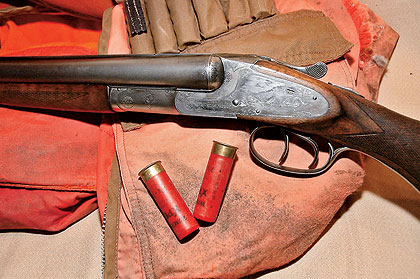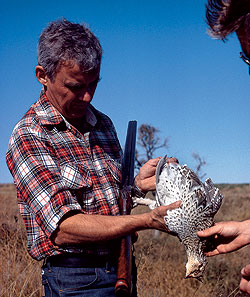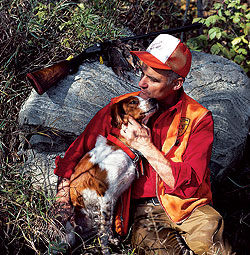One man's trash is another man's treasure.
By Joel Vance
Why do you think there are new models of every product every year? Marketing--we believe advertisers when they trumpet "new and improved," "revolutionary" and the other buzzwords of merchandising.
 This L.C. Smith and shooting vest have seen their share of days in the field. |
But a Bass-Oreno from 1920 still catches bass and I can miss game birds just as effectively with my 1913 L.C. Smith side-by shotgun as I can with whatever gun just came out yesterday, promising to make me into the shot I'll never be.
I have a love for things that carry the weight of age (maybe because I've reached antique status myself). There's a bit of magic in carrying a gun that was new when Teddy Roosevelt was the immediate past-president and, for all I know, might have hunted birds with an L.C. Smith just like mine.
Mine has tracked thousands of targets over the decades and the sweat of long-dead hunters has soaked into its lustrous walnut stock. I read books with yellowed pages that tell of hunts long ago with hunters who have been dead longer than I've been alive.
The time to collect is now, except for today's rarities for which the time to collect was 50 years ago. I could have bought a Winchester 101 over/under 20-gauge shotgun for about $259 some 30 years ago and didn't. Now? They list for $1,000 or more, depending on grade.
Many things improve with age, discounting myself, and they should be cherished, not consigned to the junk heap. No one will throw a Smith away and the wooden Bass-Oreno has become a collector's item, not to be fished with. And that's as it should be.
I am a pack rat when it comes to outdoor collectibles. Unfortunately for my budget, so are many other of today's hunters and anglers.
Outdoor junk has become outdoor collectibles. The age of the incredible find has just about passed. You aren't likely to find Mason decoys for a few dollars anymore and my Smith lists for about twice what I paid for it. But a friend did find a Mason in a local antique store a couple of years ago for a few dollars--a store that I check regularly. I met a fellow who found a Vega Whyte Laydie banjo in a barn for $35 (at least $2,000 today and probably closer to $3,000).
Not long ago a farm sale ad featured the usual assortment of rusty implements, greasy tools and plastic dinnerware€¦and a gun listing which included a couple of Model 12 Winchester shotguns, several Browning autoloaders€¦and a 28-gauge Parker Reproduction (at least $5,000).
Clutching my grimy checkbook, I headed into the country. The farm was run down and muddy, with cow flops judiciously placed to befoul the boot of the unwary bargain hunter. The buying crowd was mostly clad in implement dealer caps, frayed work shirts and overalls.
Several sported the telltale bulge of snoose in their seamed jaws. The guys fondling the guns looked as if they didn't have two $1,000 bills to rub together. They thought a Stevens single shot 12 gauge was the ultimate collector's item. I drooled, sensing that once-in-a-lifetime gun bargain. The Parker whispered, "Take me home--I love you!"
 The author savors an after-the-hunt moment with gun and dog. |
The guns would sell at noon and at 10:30 I still was the only one there who looked as if he knew the true value of those lovely guns. And then at 11:30 the gravel road filled with arriving high-dollar SUVs which, in turn, were filled with guys who looked as if they lit their Cuban cigars with $100 bills, drank single malt Scotch and traveled to England each year for the Queen's driven pheasant shoot.
The real collectors had arrived. I climbed in my rusted-out pickup and went home. Then there was the time I was quail hunting near a small Missouri town. I drove in looking for a cup of coffee, but the one café was closed. I wandered around the three or four blocks of town, looking for an alternative, and spied a sign, half hidden by a lamppost that said "€¦tique." Small, obscure town, antique store. My pulse quickened.
This could be the store with the dusty Parker Original leaning against the wall in a dark corner of the cluttered shop, with a price tag of $50. I hustled to the shop, where a woman was sweeping the sidewalk. I was dressed, as usual, in tattered field clothes and hadn't shaved. There was dried bird blood on my briar-ripped britches.
I looked as if I'd crawled out from under one of the boxcars at the railroad depot down the street, and she shrank away from me with alarm. I gave her my most reassuring grin, which possibly looked like a crazed leer since it was early, I hadn't had coffee and I was consumed with bargain lust. "Mind if I go in?" I asked.
She clutched the broom as if wishing it were a fully functional AK-47 and managed to quaver, "Nnnnnoooh." I shambled past her into the store€¦and saw hair dryers and reclining chairs. It was "Boutique," not "Antique." The worst part was, having to go back, past the woman.
Part of the charm of outdoor collectibles is that you get to use and enjoy them, and they still appreciate in value. A bank account, for all its necessity, is not going to bring down game birds or catch fish. You can't polish your bank account at the end of the day, savoring the scent of Hoppe's, as you can a vintage shotgun.
And you can't read it for pleasure and then put it back on the shelf with your other rare outdoor books. You can't look at it on the wall with your framed wildlife paintings or put it on a pedestal with your wildlife bronzes.
Derrydale is the ultimate outdoor book publisher sought by collectors although my preference is for Amwell's National Sporting Fraternity series, but there are other limited edition publishers as well: Countrysport springs to mind. Gray's Sporting Journal also published a series of limited editions. Google "Outdoor Books, hunting, limited editions" for sources.
Valuable books are made much more valuable by virtue of being limited editions, signed (or inscribed, which usually is not as desirable as a simple signature), or with a good dust jacket or slipcase. Books should be treated as carefully as glass collectibles. Once I loaned a nice book to a fellow and got it back with grease stains and a torn dust jacket. He must have read it in between bites of a slop
py Big Mac with extra fries.
 The author holds his "Elsie" while examining a prairie grouse. |
Books, like the other outdoor collectibles, should be intrinsically valuable to you--in other words they are ones you want to read, not just ones that are rare. Similarly, guns should be ones you want to use and cherish, not just rarities to stick in a gun safe forever.
And, yes, using a pristine gun will depreciate its value--but so what?
Of course, to say that something is "worth" so much is dependent on the willingness of someone to pay that much for it. Generally, used item prices depend on the market--what someone has paid for that item€¦not what they necessarily will pay for it. My L.C. Smith is worth perhaps $2,000, but no one has offered me that or anything close to it. I have a Martin D-35 guitar, which should fetch at least $1,700, but it has been in a shop for a year with no takers.
Classic decoys and double guns are probably the most sought-after and high-dollar collectibles, but duck calls, ammo boxes and even outboard motors all have their enthusiasts. In 2000, a Sotheby's auction of the decoy collection of a Dr. James McCleery fetched an astonishing $10,993,151. One shell box sold for more than $10,000.
Shell boxes are ephemeral. You don't throw away the gun, but the cardboard box is tomorrow's trash except for those few who stick them in a closet and forget them for 50 years. There is a collector's market for everything associated with hunting and fishing. Old wooden cleaning rods have their fans. A vintage bottle of Hoppe's, unopened and in the original package, would turn a collector into a slavering beast.
Almost as ephemeral as shell boxes are pocketknives, which somehow find their way through holes in pockets that shouldn't be there--maybe they cut their way out. Since a pocketknife is a hunter's best friend, it's like losing a best friend when one goes missing.
Knives also are issued in limited editions and a wise hunter does not carry one of those to slice his salami and cheese.
Wildlife original art is high dollar. Even prints of some of the best wildlife artists appreciate enormously in value. A quick check of the Easton Maryland Waterfowl Festival, among the top two or three such festivals in the country, showed a Bob Kuhn original acrylic listed at $125,000. Van Gogh brings more, but Vincent couldn't paint a duck to save his life (of course nothing else saved it either, once he pulled the trigger on a cheap pistol).
I bought a Terry Redlin print many years ago when he was selling them out of the trunk of his car for about $36. Today it sells for more than $800. Sometimes I have good sense.
Sometimes. It is as American as apple pie and Mom to try to screw someone out of something valuable. Once, a gun writer I know got a call from a fellow in a nearby town saying he had an old Fox shotgun and did the writer want to look at it. A.H. Fox shotguns are among the several fine American doubles of yesteryear and, yes, the writer not only wanted to look at it--he wanted to buy it if possible (i.e., "screw the guy out of it").
Guns are among those items that, no matter how anemic the discretionary income budget is, they demand to be acquired, especially guns with collectible value. So the writer packed his tattered checkbook and off he went.
The gun owner--an old man in a bathrobe--hobbled to the door, obviously in some pain.
The writer, a man of great compassion, immediately surmised that the gun owner wouldn't be using his gun any time soon and, given his obvious discomfort, might possibly be checking out for the Great Covert in the Sky. The writer hoped (1) the old man had no heirs; and (2) didn't know the value of a double gun.
The man brought out his Fox, which proved to be an early model with a serial number in the 200s--possibly put together by Ansley Fox himself. It was a treasure and the gun writer asked in a shaky voice if the old fellow might be interested in selling it. "Oh, I don't know," the guy said. "It was daddy's gun€¦I'd have to have a pretty good price for it."
The writer's spirits sank as he mentally calculated how much he had available and how much credit he could muster at the bank. Obviously the old man was going to ask for body parts in addition to huge stacks of money.
"I reckon I'd have to get $150 out of it," the old man said and the writer nearly dislocated his shoulder reaching for his checkbook.
The old fellow threw in the original mutton leg gun case and the original wooden cleaning rod and gimped to the door with the writer who finally felt a slight wash of shame for having taken advantage of an old man obviously suffering from a dreaded terminal disease. "I see you're not feeling real well," he said diplomatically.
"Yes," the old man said. "I just got circumcised."
My immediate thought was You sure did.
I wrote about the incident and got really nasty letters from people who thought I'd been the one who took advantage of a sick old man. Wasn't me, I told them, although I didn't add that I probably would have done the same thing, given the chance (and so would they, if they'd been honest).
The search for a bargain is as universal and historic as greed itself and rare is the man or woman who will tell a seller that he has seriously undervalued something the man or woman wants. Watch the Antique Roadshow some time and see how many people come in with some scraggy item they bought for a couple of bucks at a yard sale that turns out to be a one-of-a-kind relic, worth $150,000. Even had they known the real value of the $1.50 bargain, they wouldn't have told the seller.
Somewhere there is a person with a checkbook and a yen for an old L.C. Smith Three Grade double, but only if he can get it for $125 from an unsuspecting old geezer. I own a Three Grade that I would sell, and I€ˆconfess to being a geezer€¦but you ain't gonna get it for $125.
Joel Vance is the author of Grandma and the Buck Deer (soft cover $15); Bobs, Brush and Brittanies (hardcover $22); Tails I Lose (hardcover $25); Down Home Missouri (hardcover $25) and Autumn Shadows (limited edition $65). Available from Cedar Glade Press, Box 1664, Jefferson City MO 65102. Add $2/book for S/H.






